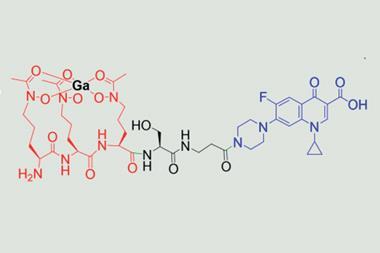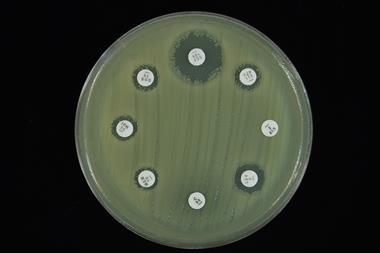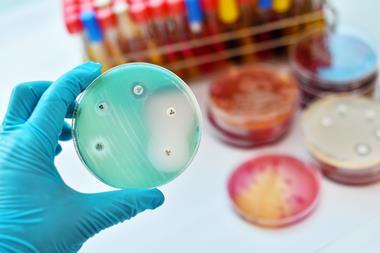It’s been almost 10 years since the world was warned of a post-antibiotic apocalypse. Katrina Megget takes a look at the initiatives trying to support antimicrobial R&D

In January 2013, the World Health Organization (WHO) warned the world was heading for a ‘post-antibiotic era’ unless action was taken against the growing risk of antibiotic resistance. Comparisons with climate change and terrorism were made. Sally Davies, the UK’s chief medical officer at the time, dubbed the situation a potential apocalypse. Meanwhile, fingers were pointed at big pharma, as the antibiotic pipeline dwindled and company after company abandoned the space. Initiatives launched, governments scrambled, antibiotic prescribing was curtailed.
According to the latest WHO report, there are 43 new antimicrobials in clinical development, with 26 of those targeting the WHO’s priority pathogens list, while more than 250 compounds are in preclinical development. 12 drugs have been approved since July 2017. ‘There is some progress,’ says Ana Nicholls, managing editor of the Industry Briefing at the Economist Intelligence Unit. ‘But the WHO itself describes this progress as insufficient. The pipeline of new antibiotics is just too thin.’
Some progress is better than none, however. Many point to the public warnings of Armageddon – particularly the influential 2016 O’Neill Review, commissioned by the UK Government – as being the jolt for change, to take antibiotic resistance seriously and put it on the political and international agenda.
Jim O’Neill himself believes his report catapulted antimicrobial resistance (AMR) into the public and political consciousness. In the foreword to a 2019 follow-up report, he mentions G20 summits and the 2016 UN political declaration on AMR. ‘Now, these initiatives might have happened if our review had not existed, but I suspect not.’
O’Neill notes the two biggest shifts since his review are the number of AMR researchers and the amount of money going into early-stage research. Indeed, off the back of the dire warnings and pace at which companies – including AstraZeneca, Roche and Eli Lilly – were exiting the antibiotics space, came a raft of initiatives to boost research and entice firms back.
Prior to the review there was the Infectious Disease Society of America’s (IDSA) 10 by 20 initiative (aiming for 10 new systemic antimicrobials between 2010 and 2020) and the Innovative Medicines Initiative’s New Drugs for Bad Bugs programme. Then came Carb-X, a non-government organisation with a budget of $480 million (£340 million), as well as the Global Antibiotic Research and Development Partnership (GARDP), and the $165 million Repair (Replenishing and enabling the pipeline for anti-infective resistance) impact fund, among others. Meanwhile, the first charity focused on the cause, Antibiotic Research UK, was launched. And in January, the University of Oxford created a new AMR Research Institute with a £100 million donation from petrochemical company Ineos.
These push incentives have paved the way for early-stage research and have allowed smaller biotech companies to enter the field. According to Cornelius Clancy, associate professor of medicine at the University of Pittsburgh, US, and member of the IDSA’s AMR committee, the IDSA’s 10 by 20 initiative was a success. ‘We got to about 14 [US]-approved drugs, so hit the number goal.’
But there are concerns innovation isn’t what it should be. The WHO calls the drugs approved since 2017 of ‘limited clinical benefit’. Even the US trade body Pharmaceutical Research and Manufacturers of America (PhRMA) admits we aren’t there yet. ‘We’ve had increased attention on the problem, but we still don’t see the robust and diverse pipeline that is needed to solve this problem,’ says Jocelyn Ulrich, PhRMA’s deputy vice president, policy and research. However, the WHO is more upbeat about the preclinical pipeline.
Right now it’s an opportunity. We can solve this before it becomes the next crisis
Jocelyn Ulrich, PhRMA
While these push incentives have created the much-needed boost to R&D, challenges have emerged over the past decade, Clancy says. The Repair finance package, for instance, was launched in 2018 by life science investor Novo Holdings with the aim to fund antibiotics companies in phase 1 clinical trials; the idea being (likely bigger) other companies would then take over late-stage development and commercialisation. However, the interest wasn’t there. It’s a similar story with Carb-X. The crux, as Novo Holdings identified, is that incentives also need to fund more costly late-stage development, not just early-stage research.
That lesson prompted the launch of the $1 billion AMR Action Fund in July 2020. The fund is supported by more than 20 pharma companies including Pfizer, Johnson & Johnson and Novartis, and aims to bring two to four new antibiotics to market by 2030. What’s different compared to previous iniatives is big pharma’s cash contribution and technical know-how, with the focus on late-stage development of antibiotics with the most unmet need.
According to Clancy, the fund is crucial. ‘Pharma has a responsibility to invest in antibiotic development, so coming together in the AMR Action Fund is them stepping up to that responsibility.’ Furthermore, he says, it’s industry’s acknowledgement that the success of many blockbuster drugs, such as cancer treatments, is dependent on antibiotics to prevent and treat infections.
But the AMR Action Fund isn’t enough, says Clancy, despite providing a lifeline to companies in the later stages of development. Even the fund itself acknowledges this. ‘The antibiotic pipeline is fragile, and while additional funding is a short-term solution, longer term policy changes are needed to incentivise and strengthen a constant flow of innovation,’ it said in a statement in February. Ulrich calls it a hand in glove approach. ‘Industry is doing its part,’ she says. ‘This should inspire governments to do their part. Policy change is also necessary for this fund to be successful.’
Pull it together
Policy changes have begun, mainly aimed at easing regulatory burdens. The 2012 US Gain (generating antibiotics incentives now) Act grants companies expeditated regulatory review and an additional five years’ market exclusivity for qualifying products. Five years after coming into force, the US Food and Drug Administration had designated 147 programmes eligible and approved 12 such drugs.
‘The regulatory framework is working at reducing barriers to allow faster development and that’s been beneficial and important, but it’s not sufficient on its own,’ says Ulrich. ‘These products need to have a return on investment to succeed.’ And herein lies the rub. When stewardship measures mean new antibiotics are held in reserve, an exclusivity extension does little to ensure firms can recoup development costs. In other words, the existing economic model based on volume sales doesn’t work in a world where antibiotic use is conserved. ‘The marketplace is broken,’ says Clancy. ‘The maths isn’t going to work for pharma.’
This has played out with the recent failures of three companies – Aradigm, Achaogen and Melinta – which, despite having approved antibiotics, were forced to file for bankruptcy. As Nicholls notes, previous incentives have not addressed the basic problem of market failure. Clancy warns the impact of incentives will be blunted if companies can’t stay in the business: ‘We need to come to a system that will reflect the value of antibiotics.’
That means a pull incentive focusing on a reimbursement model that guarantees return on investment. Industry and various health economists have been calling for change for years – 74% of companies surveyed for last year’s AMR Industry Alliance report said they were likely to increase investment in AMR if commercial models improved. Yet governments have been slow to respond. ‘We’ve had a lot of focus on the low-hanging fruit of push incentives and less on pull incentives because they are trickier to design and require working out what it costs to develop an antibiotic,’ explains Lotte Steuten, vice president and head of consulting at the UK’s Office of Health Economics. ‘We really need a combination of push and pull incentives to address AMR.’
Timeline charting initiatives to tackle AMR
Initiatives to spur research and development for new antibiotics

© Getty images
2010
IDSA launches 10 by 20 initiative
'Our audacious but noble aim is the creation of a sustainable global antibacterial drug research and development enterprise with the power in the short-term to develop 10 new, safe, and effective antibiotics by 2020.'
2012
Innovative Medicines Initiative launches its first call for proposals under the New Drugs for Bad Bugs programme
The public–private partnership model is based on a 50:50 partnership between the European Commission and the European Federation of Pharmaceutical Industries and Associations
2012
US Gain Act passed
President Obama signs the generating antibiotic incentives now Act into law as part of the Food and Drug Administration Safety and Innovation Act. This bipartisan legislation extends by five years the exclusivity period during which certain antibiotics can be sold without generic competition
2014
Antibiotic Research UK formed as world’s first charity for AMR
Antibiotic Research UK was formed by a group of scientific experts from UK universities and biotech companies
2016
Carb-X established
Combating antibiotic-resistant bacteria biopharmaceutical accelerator (Carb-X) is a global non-profit partnership. It has up to $480 million available to invest 2016–2022 to accelerate antibacterial research
2016
GARDP created by the WHO and Drugs for Neglected Diseases initiative
The global antibiotic research and development partnership was designed to promote innovative solutions to the challenge of antibiotic resistance and aims to deliver five new treatments by 2025, focusing on sexually transmitted infections, sepsis in newborns, and infections in hospitalised adults and children
2016
Final O'Neill review published
The review, which was commissioned by the UK government, concluded that if we don’t undertake big policy initiatives, by 2050 there could be 10 million people around the world dying from AMR-related illnesses
2018
Novo Holdings establishes the Repair impact fund
The fund has a total budget of $165 million to invest in companies involved in discovering and the early-stage development of therapies targeting resistant microorganisms
2020
AMR Action Fund launched
The AMR Action Fund has since become the world's largest public–private partnership supporting the development of new antibiotics. It aims to bring two to four new antibiotics to patients by 2030
2021
Ineos donated £100m to the University of Oxford for antimicrobial research centre
The donation by Ineos is one of the largest ever given to a UK University
In July 2019, the UK announced a pilot of a new economic model; the first in the world. The subscription model intends to explore a new health technology evaluation process and new payment model that would delink profit from sales. It will be trialled in two antimicrobials: Pfizer’s Zavicefta (ceftazidime + avibactam) and Shionogi’s Fetroja (cefiderocol), with contracts expected to be signed in early 2022.
In the trial, the manufacturers will enter into three-year contracts, with options to extend for up to another seven years, over which time they will receive an annual, value-based payment. The value of the drugs will be based on clinical value but also the broader value to the NHS, such as spectrum of action and preventing pathogen transmission. The fixed annual payment agreed via commercial discussions with the separate companies, will be guided by evaluation from the National Institute for Health and Clinical Excellence (Nice) and include the role of stewardship strategies.
Steuten calls the move groundbreaking but questions the cap of £10 million suggested for the annual payment, which is based on the UK market share of all pharmaceuticals including generics. ‘You could argue the cap is too low,’ she says. ‘Doubling that to £20 million, in line with the UK’s market share of novel pharmaceuticals, would be more justifiable for developing a novel antibiotic.’
Ulrich says there is promise and expects this type of pull incentive could stimulate innovation and the development of riskier drugs for the more difficult pathogens. ‘The industry is very encouraged by the UK model but we would like all G7 countries to have similar solutions. If they can align then we might get enough traction to move the needle here.’
The US has a similar subscription programme making its legislative way through Congress, known as the Pasteur Act (pioneering antimicrobial subscriptions to end upsurging resistance). This could see drug firms receive a payment between US $750 million and $3 billion for novel antimicrobials, such as those treating multi-drug resistance. Congress is also considering the Disarm Act, which would direct Medicare (the national health insurance programme for older and disabled people) to reimburse hospitals for new antibiotics.
Both Sweden and Germany are also exploring reimbursement mechanisms, says Colm Leonard, consultant clinical advisor, Centre for Health Technology Evaluation at Nice. ‘We recognise that the UK alone will not fix the market entry failure unless other countries follow suit with similar approaches.’
Indeed, tackling the market failure on a global scale is the missing piece of the puzzle, says David Leonard, strategy consultant, pharma and life sciences at Strategy&, part of the PwC network. ‘Although progress has been made in the UK, we still see uncertainty around the level of international collaboration required to create a sufficiently large incentive that makes investing in antibiotic R&D as attractive as other therapeutic areas.’ If more countries follow the UK’s lead, the antibiotics market has a chance at being viable, he says.
However, there are concerns Covid-19 has pushed AMR off the radar, although, the pandemic also provides an opportunity, highlighting the risk of infectious diseases. In addition, lessons from Covid vaccine development could be applied to antibiotics, such as collaboration between companies and healthcare providers, data sharing and flexibility in the regulatory pathway. Nicholls points to the financial risk some governments have committed to by signing contracts up front for vaccines – this too could work for AMR.
There is a growing sense of optimism; industry is seemingly re-engaged as a result of reimbursement conversations. Ulrich hopes within the next one to three years there will be other pull incentives similar to the UK that will incentivise global development, and within five to 10 years, a more innovative and diverse pipeline. ‘Right now it’s an opportunity,’ she says. ‘We can solve this before it becomes the next crisis.’
Acknowledgement
Thanks to Mathew Upton from the University of Plymouth, UK, for helpful discussions.












No comments yet